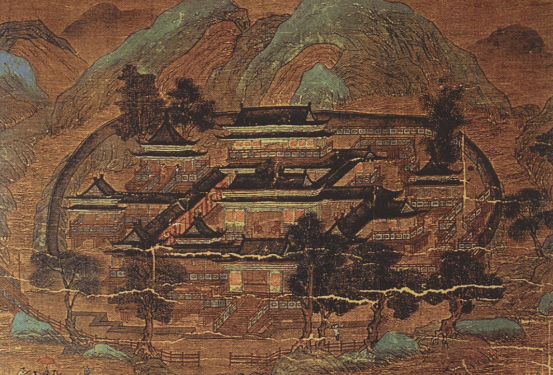
Chinese painting boasts a rich history, with countless masters contributing to its development. Here are four particularly renowned figures, each making significant contributions to landscape painting and deeply influencing Chinese art.
Wang Wei (701–761)
Living during the glorious Tang Dynasty, Wang Wei was celebrated equally for his poetry and painting. Later critics, like Dong Qichang in the 17th century, honored him as the founder of the revered Southern school of painter-poets, valuing personal feeling and expression above surface copying. Wang Wei is particularly famous for his innovative monochrome ink landscapes, especially delicate snow scenes.
Dong Yuan (?–962)
An official during the Five Dynasties, Dong Yuan became a central figure in landscape painting. Dong Yuan developed unique brushwork — soft strokes resembling hemp fibers (披麻皴) — perfectly suited to portray the gentle, rolling hills of southern China. His technique involved building scenes with carefully arranged dots and lines that seemed spontaneous. Viewed from a distance, his paintings create vivid, almost magical worlds. This elegant and influential style shaped generations of later artists.
Fan Kuan (ca. 950–1032)
A Song Dynasty painter known for his strong character, Fan Kuan believed true art came directly from observing nature. He retreated to mountains like Cuihua, dedicating himself to studying the effects of weather, atmosphere, and seasons. People of his time admired his deep connection with the mountains. His monumental masterpiece, Xishan Xinglv Tu (Travelers among Mountains and Streams), powerfully illustrates the Daoism ideal of humans within vast nature, making viewers feel small yet connected. This work became a model for centuries.
Mi Fu (1051–1107)
A brilliant scholar, calligrapher, and painter of the Song Dynasty, Mi Fu was a highly individualistic artist. In painting, he broke from tradition. Inspired by the misty rivers and hills of Zhenjiang, he developed a revolutionary technique using extremely wet ink washes and horizontal strokes. This method, later famed as “Mi dian”(米点), masterfully captured the feeling of rainy, cloud-covered southern Chinese scenery. His spontaneous, expressive style placed him firmly within the Southern School lineage of Wang Wei and Dong Yuan.
原创编写 版权所有 侵权必究! 每日更新 个性化阅读 英语飙升!
2.2. Fan Kuan’s retreat to Cuihua Mountain suggests he ______.
A feared social responsibilities
B valued firsthand observation
C disliked urban lifestyle
D pursued religious isolation
解析:选B。B 推理判断题。根据第四段的“believed true art came directly from observing nature”可知,范宽相信艺术源于观察自然,由此可推断,他的隐居行为与此理念一致。故选B。
4.4. According to the passage, both Wang Wei and Mi Fu were noted for their ______.
A poetic creativity
B academic excellence
C calligraphic skills
D official careers
解析:选B。B 推理判断题。根据第二段和第五段可知,王维作为唐代“文人画家”代表,其诗歌与绘画成就均体现深厚的学术文化底蕴;米芾为 “a brilliant scholar(杰出学者)”,强调学术成就。选项B“学术造诣”通过“scholar”与“文人身份”的关联,概括两人共通的文化修养核心。故选B。
